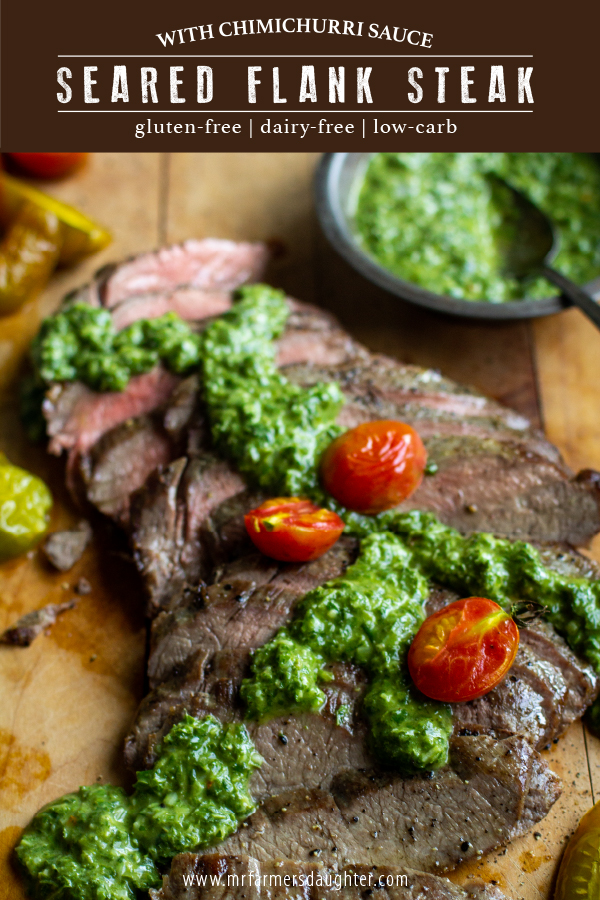
[maxbutton name=”Jump To Recipe”]
So … steak. It’s taken me a long, long time to be comfortable with cooking it to the desired doneness. As a food stylist, I can cook a mean steak that looks perfectly done on the outside but honestly, it wasn’t until just a few years ago that I was comfortable cooking to someone else’s preference – medium-rare, medium or even medium well. I’m still a little off sometimes, especially when the steak has areas that are thinner because they cook faster. Those pieces are inevitably going to be done a little more than the center of the steak. This is the reality of cooking real food.
One of the best things I did was order a box of steaks from a farmer friend who raises grass-fed beef. He’s a farmer on our Weston A. Price Foundation supplier list and has become a significant part of my farm-to-table life. I call him up (he’s Amish but thankfully, has a phone) and order a certain dollar amount of steaks and ground beef. Then I go pick it up in the next couple days. It’s a great way to support my local farmer and get the best meats possible.
The ground beef is so red, it put the “grass-fed” supermarket beef to shame. I’m considering doing a comparison post on it soon. Look for it coming up.
Having a freezer full of steak is what forced me to figure out the best way to cook it in a way that my family loves. We’re not big steak people. Give me a chicken breast any day, but, over time we’ve grown to love it. So many things you can do with leftover steak too, as long as it’s cooked the right way.
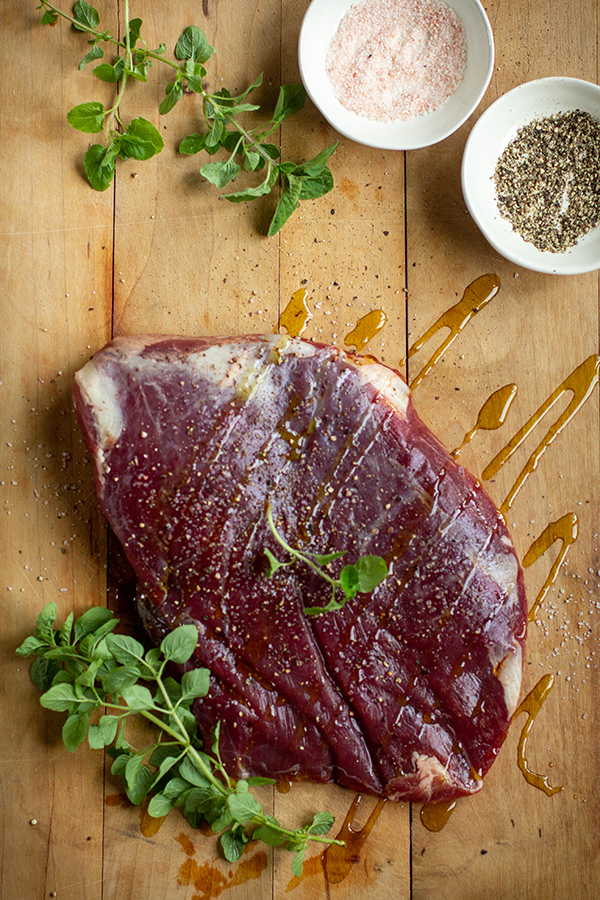
I had one more flank steak left in my freezer so I used that for this recipe. Now, flank steak isn’t known for its tenderness like filet. It’s a cut that should be minimally cooked to a max of medium. I’ll show you how I add a little grace and am still left with very tender pieces of meat.
Flank steak comes from the underbelly of the cow – a part where the muscles are regularly worked. Typically, the less a muscle is worked, the more tender it is. Flank steak is a lean piece of meat that takes well to marinades. Marinating tenderizes the dense muscle meat and adds flavor throughout.
I have a simple way to marinate flank steak but you will have to plan ahead a bit. Minimally, I would marinate flank steak for two hours. It’s even better if you can prep it the day before and allow it to sit in the refrigerator, marinating overnight. All depends on how good you are at planning your meals. For me, it’s hit or miss.
The absolute simplest way I’ve found to marinate this meat is to sprinkle it with Montreal seasoning (I get mine from Calicutts in Hershey, PA), sprinkle it with organic Worcestershire sauce and some olive oil. I do this on both sides, then place in a glass container (these are great!) and allow it to marinate in the refrigerator. When I start working on the rest of the meal, I remove it from the fridge and let it come to room temperature. Having your steak at room temperature will allow it to cook more evenly.
The next thing I do is get a good cast iron pan screaming hot. If you don’t have any cast iron … I’m sorry. I’ll say a little prayer for you. Here’s a post about why I think everyone needs a few classic cast iron pieces and how to take care of them. In lieu of cast iron, use the heaviest, best quality pan you have that can go directly into the oven (set to 400˚). You will want to get it very hot and have your steak and tools ready.
Before we throw that steak in the pan though, let’s talk about thermometers. I have a digital meat thermometer that monitors the temperature of the meat and alerts me when it has reached the set temp. I would highly suggest this one. I’m on my third one. I’ve gone through two as a food stylist and one at home. They’re accurate and reliable.
Now, back to the stove and your screaming hot pan. Throw that flank steak in the pan and don’t leave its side! Make sure your range hood is on because it’s going to smoke. A lot! Allow it to brown on one side for 3-4 minutes, depending on your pan temp. Flip it when it’s crusty in the right places. Brown that side for 2-3 minutes and put it directly into your oven set to 400˚. It will brown more in there but it’s going to cook quickly. Make sure to insert the thermometer into the thickest part of the meat and set it to your desired doneness before placing in the oven.
Once the thermometer alerts you the set temp, remove it from the oven and immediately cover it loosely with foil or lid.
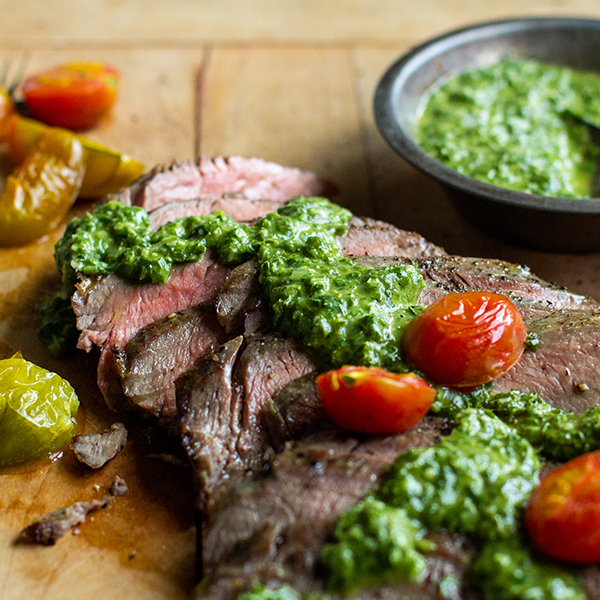
Allow to rest for 5-10 minutes until the juices stop flowing. There’s no need to poke it or cut it with a knife. If your thermometer is good, you can trust it. Extra holes allow active juices to escape and you lose them.
Also, do not remove the probe yet. The steak will continue to cook for up to five minutes, increasing in temperature. For this reason, it’s a good idea to set your thermometer 5 degrees less than you like. When the juices stop flowing, the temperature will begin to drop slowly since it’s covered.
I’ve included a handy steak temperature chart for you to reference. Feel free to pin it or print it out to keep it for reference.
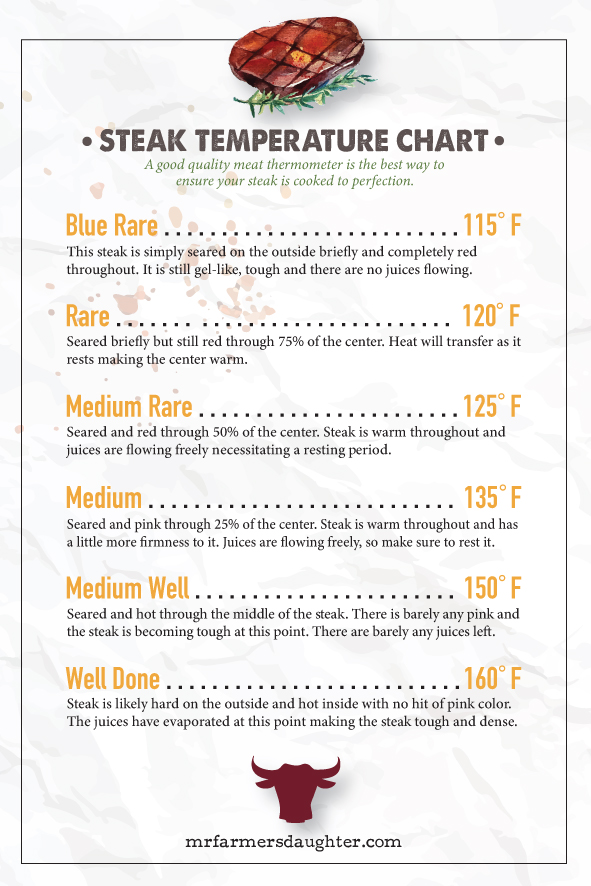
Once the steak is rested, serve immediately. I suggest serving with a chimichurri (recipe below) if it’s flank steak. It’s my new favorite!

Recipe
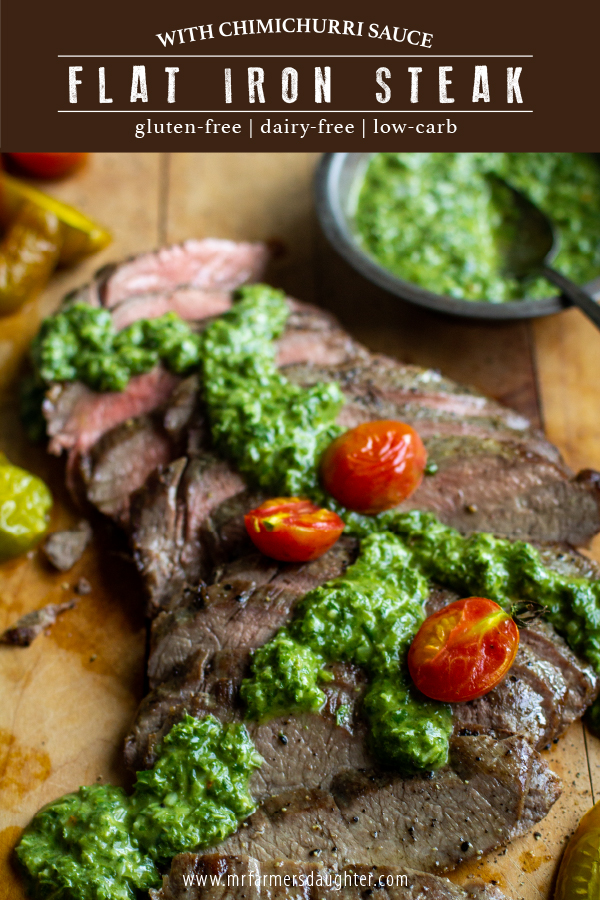
- 1 grass-fed flank steak (3-4 lbs.)
- Montreal seasoning (My favorite is Calicutts Spice Co.)
- Worcestershire sauce
- Olive oil
- Sprinkle the flank steak with seasonings, Worcestershire sauce and olive oil on both sides.
- Marinate for a minimum of 2 hours and up to 24.
- When ready to cook, bring to room temperature about 30 minutes before cooking.
- Heat up a heavy cast iron pan on the stove top and sear on both sides for 3-4 minutes each.
- Immediately place in the oven with an oven safe thermometer set to desired temperature.
- When the steak reaches temp, remove from oven and rest for 5-10 minutes to finish cooking.
- Serve immediately by slicing thinly.
- Goes great with chimichurri sauce!

- 2 cups of your favorite herbs. (parsley, oregano, basil, or thyme are good choices.)
- 2 tsp. chopped garlic
- 2 scallions
- ½ tsp. red pepper flakes or to taste
- ½ tsp. salt
- ½ tsp. black pepper, ground
- juice of one lime
- Enough EVOO to make a smooth paste in a food processor.
- Place all ingredients into a food processor and pulse until it forms a smooth paste. Add EVOO to desired thickness. Serve as a condiment with thinly slice flank steak.
